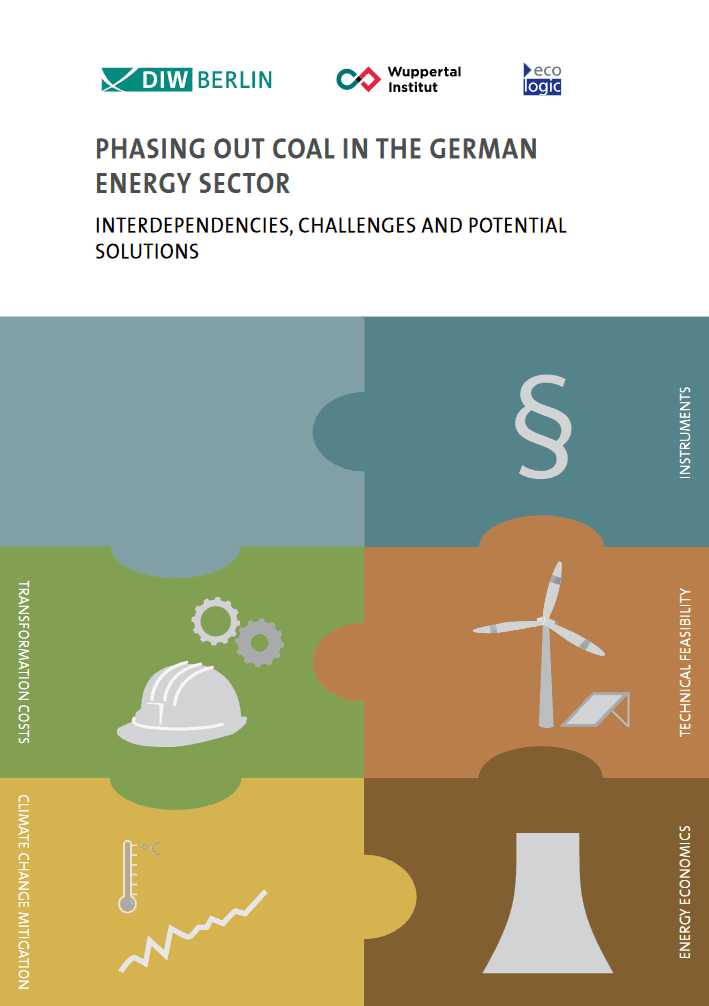Phasing out Coal in the German Energy Sector

Dear readers,
The ‘Growth, Structural Change and Employment’ Commission appointed by the German Federal Government convened for the first time on 26 June 2018. In the first quarter of 2019, it is to submit an action plan to gradually reduce and phase out coal-fired power generation (including a final deadline), and develop proposals for economic, social, structural policy and remediation-related flanking measures. The Commission’s mandate specifies the following key tasks as its remit:
- Create specific prospects for new, future-proof jobs in the affected regions,
- Develop a mix of instruments combining economic development, structural change, social acceptability, societal cohesion and climate change mitigation,
- Identify necessary investments in the regions and economic sectors affected by the structural change, which are to be subsidised via a fund that supplements the existing financing instruments and mainly draws on Federal Government resources,
- Formulate measures to reach the 2030 greenhouse gas reduction target for the energy sector, in particular measures related to coal-fired power generation, including a comprehensive impact assessment and
- Formulate measures for the energy industry to contribute to closing the gap to the 2020 target of reducing greenhouse gas emissions by 40% compared to 1990 by as much as possible.
Relevant aspects of the options and requirements for reducing and phasing out coal-fired power generation have been under debate for several years. This process has produced a range of strategies, analyses and arguments, outlining how coal use in the energy sector could be reduced and phased out in the planned time frame, and determining structural policy measures suitable to support this. This Coal Report studies the existing analyses and provides an overview of the state of debate. It is intended to provide information on facts and contexts, present the advantages and disadvantages of individual courses of action, and reveal the respective scientific backgrounds. It strives to take a scientific and independent approach, and present facts in concise language, making it easy to follow for readers who are not experts in the field, without excessive abridgements or provocative statements.
Chapter 1 is dedicated to the relevant energy industry aspects of reduction and prospective phase out of coal-fired power generation. Starting with the description of the existing coal-fired power plants and lignite open-cast mines, it incorporates an overview of the cost structures and pricing, and addresses the implications of coal-fired power generation for profitability of gas-fired power plants and risks of future grid bottlenecks. It closes with a presentation of the current regulatory framework for plant closure, focusing on guaranteeing security of supply and the duties of transmission system operators and the Federal Network Agency (BNetzA) for monitoring system security to avoid potential critical situations and determine intervention options.
Chapter 2 presents the climate policy framework relevant for the use of coal in the energy sector. It outlines the consequences of climate change, the Paris climate targets and international trends in use of coal, and derives cornerstones for reducing coal-fired power generation in Germany.
Chapter 3 gives an overview of the technical aspects of an energy supply without coal. It covers requirements like increased flexibility and energy efficiency, expanding renewable energies and electricity grids, using natural gas as a bridge technology and the role of storage systems. It also presents the scope and potential solutions to ensure that electricity and heat can be securely supplied at all times.
Chapter 4 considers the transformation costs of phasing out coal. Based on an overview of the local economies in lignite regions it points out employment effects and options for successful structural change. It also details the impact of the transformation on the electricity wholesale price and on the costs of remediating open-cast mines.
The final chapter, Chapter 5, describes potential policy instruments to reduce coal use in the energy sector. The Report is supplemented with a list of coal-fired power plants, which provides both technical specifications as well as details of the CO2-emissions of all German lignite and hard coal-fired power plants with electrical outputs of over 50 MW.The energy transition process is a complex, challenging transformation. Based on many questions and problems, the information currently available presents us with a series of clearly defined jigsaw pieces, which we can combine in a variety of ways. We hope that the ‘Coal Report’ will contribute to a transparent presentation of the available options and their implications, to promote an evidence-based discussion on reduction and phase-out of coal-fired power generation. In this light, we hope you find it an informative and interesting read.
Prof. Dr. Claudia Kemfert, German Institute for Economic Research
Prof. Dr. Manfred Fischedick, Wuppertal Institute for Climate, Environment and Energy,
Dr. Camilla Bausch, Ecologic Institute